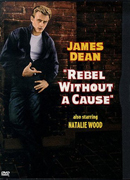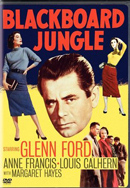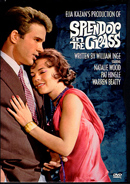I’ve always loved old movies, like Bye Bye Birdie and Rear Window. On a rainy day, there’s nothing better than watching an old movie and slipping into a story from long ago. Here are three classic movies that I suggest you check out. They are suspenseful and thought provoking, and also about teenagers and their struggles in the past. If you’ve ever wondered what life would be like during the era of hair grease and bobby socks, after watching these movies you might be surprised at the differences—and similarities—between then and now.
Rebel Without a Cause (1955)

Because this movie is so well known, I wanted to think that it was over-rated. But when I saw it, I realized that it’s famous for a reason—it’s a really good movie. It doesn’t glamorize or criticize what it’s like to be a teenager; instead it represents teen angst in a very real, timeless way.
Rebel Without a Cause traces the frustrated and restless Jim Stark (James Dean) through his first day of school in a new town (Los Angeles), where he is treated as a social outcast by a group of violent kids—think knife fights and illegal car races. Even though a knife fight might be considered “quaint” by today’s standards, the scene is still suspenseful. Jim also has to deal with his overbearing mother and a weak, distant father.
The film packs a lot into one day: after the leader of the pack, Buzz, dies in a fight, Jim runs off with Buzz’s girlfriend, Judy (Natalie Wood), and they befriend a younger, lonely boy named Plato. Buzz’s friends try to wreak havoc on Jim’s life so Jim, Judy and Plato escape to an old abandoned mansion. For a short while they are able to have fun and act like the kids they never get to be—until Buzz’s friends show up, and it becomes clear that things have gotten out of hand. This movie is the definition of a classic—it made both James Dean and the phrase “rebel without a cause” iconic.
Although the haircuts are different (think guys with slicked-back hair and girls with pinned-up curls), the themes of frustration, loneliness and the need for acceptance are feelings that teens today still understand. The film is a strange combination of the childlike innocence and surprising maturity that comes with being a teenager. Even though this movie is 50 years old, the teens in it are much more realistic than teens in movies today like Mean Girls (no offense at all to Mean Girls). Even if you don’t like old films, this is one movie you should see.
Blackboard Jungle (1955)

If you’ve ever loved movies like Dead Poets Society, Freedom Writers or Take the Lead, then you might like Blackboard Jungle, another story about a teacher inspiring disenchanted students—this time in the 50s.
The movie is a little slow and repetitive—after a while I got tired of watching mean kids doing mean things while the determined teacher, Mr. Dadier (Glenn Ford), shows commitment and patience. However, I still found it interesting to see how the formula of unruly kids vs. inspired teacher was portrayed in 1955. Unlike Take the Lead, the kids in Blackboard Jungle don’t learn how to salsa and tango; instead, by the end of the movie they turn from street kids to teenagers with morals and respect for authority—and of course, they’ve been that way the whole time, it’s just that no one had faith in them.
In the beginning, the kids yell racist remarks during class, break a teacher’s records and even corner a female teacher alone in the library. But over time, Mr. Dadier finds ways to get the kids to settle down and engages them in class. He gets the “ringleader” of the group, Gregory Miller (Sidney Poitier), to show interest in learning, and the other students slowly follow his example. He also plays a short cartoon of Jack and the Beanstalk, and the kids are so excited talking about the themes that they begin to learn without even knowing it.
Blackboard Jungle was the first mainstream movie to play a rock ‘n’ roll song (“Rock Around the Clock”). Teens were so excited about the music that violence and vandalism erupted at theatres.
Although I didn’t love this movie, it was interesting to see what kids might have been like back in the 50s, and there’s enough history in it that I would recommend it.
Splendor in the Grass (1961)

The title sounds like a movie about sunny picnics and people having fun. Fortunately, the movie is much more interesting than that—it deals with teen sexuality, which surprised me, since the movie was made in 1961.
Splendor in the Grass tells the story of Deanie (Natalie Wood) and Bud (Warren Beatty), two high school sweethearts who are the “perfect couple”— except that while Deanie is considered a “nice girl,” Bud wants something more. Although he and Deanie love each other, Bud decides to follow the advice of his father and finds a new, promiscuous girlfriend. Meanwhile, Deanie’s mother urges her to remain a respectable young girl and abstain from sex with Bud, believing that he might find her less desirable if she were so easily won.
The differing expectations of what a young woman should be literally drive Deanie insane. While Bud’s off with his new girlfriend, Deanie is so conflicted about being a “good girl” versus being with Bud that she is eventually institutionalized. When Deanie has her breakdown, I hated all of the adults in the movie who tried to tell her exactly how to act—no opinion of theirs should cost a girl her sanity.
While she is in the institution, Bud and Deanie slowly grow apart. Bud is living his own life while Deanie is trying to take back her sanity.
Splendor in the Grass is a must-see for any teenager. The movie shows the pressure placed on teens, especially teenage girls, in the late 20s (when the movie takes place). Women were grouped into two categories (slut or prude), while people expected men—especially wealthy men, like Bud—to get what they wanted. After this movie, I promise you will be thankful to be living in the 21st century.